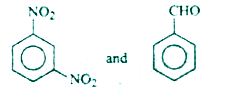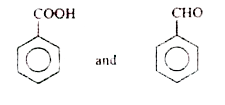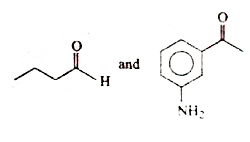One mL of an organic compound was dissolved in ethanol and a very small drop of dilute alkali was added to it and them a drop of phenolphalein was added. The red colour of the indicator was seen . The mixture. was then heated . The colour disappeared in a few minutes . The organic compound is most likely to be
an aldehyde
a ketone
a carboxylic acid
an ester
The correct Answer is:D
To solve the question, we will follow these steps:
Step 1: Understand the Reaction Setup
We start with 1 mL of an organic compound dissolved in ethanol. A small drop of dilute alkali is added, followed by a drop of phenolphthalein.
Hint: Identify the role of each component in the reaction.
Step 2: Analyze the Indicator
Phenolphthalein is an acid-base indicator that turns red in basic solutions (pH > 9). The appearance of red color indicates that the solution is basic, which means that the alkali has not reacted completely with the organic compound.
Hint: Recall the pH range for phenolphthalein to change color.
Step 3: Heating the Mixture
After observing the red color, the mixture is heated, and the color disappears after a few minutes. This indicates that the alkali has reacted with the organic compound, consuming the base.
Hint: Consider what happens to the pH when a reaction consumes a base.
Step 4: Determine the Nature of the Organic Compound
Since the alkali is consumed upon heating, we can deduce that the organic compound likely undergoes a reaction with the alkali. A common reaction that fits this description is the hydrolysis of an ester in the presence of a base (saponification).
Hint: Think about reactions that involve alkali and organic compounds, particularly those that lead to a color change.
Step 5: Eliminate Other Possibilities
Carboxylic acids would not produce a red color with phenolphthalein since they are acidic (pH < 7). Therefore, they can be ruled out as possible candidates for the organic compound.
Hint: Review the properties of carboxylic acids and their behavior with phenolphthalein.
Step 6: Conclusion
The organic compound is most likely an ester, as it reacts with the alkali, leading to the consumption of the base and the disappearance of the red color upon heating.
Final Answer: The organic compound is most likely an ester.
---
We start with 1 mL of an organic compound dissolved in ethanol. A small drop of dilute alkali is added, followed by a drop of phenolphthalein.
Phenolphthalein is an acid-base indicator that turns red in basic solutions (pH > 9). The appearance of red color indicates that the solution is basic, which means that the alkali has not reacted completely with the organic compound.
After observing the red color, the mixture is heated, and the color disappears after a few minutes. This indicates that the alkali has reacted with the organic compound, consuming the base.
Since the alkali is consumed upon heating, we can deduce that the organic compound likely undergoes a reaction with the alkali. A common reaction that fits this description is the hydrolysis of an ester in the presence of a base (saponification).
Carboxylic acids would not produce a red color with phenolphthalein since they are acidic (pH < 7). Therefore, they can be ruled out as possible candidates for the organic compound.
The organic compound is most likely an ester, as it reacts with the alkali, leading to the consumption of the base and the disappearance of the red color upon heating.
Similar Questions
Adding a few drops of dilute HCl to freshly precipated ferric hydroxide produces a red-coloured colloidal solution. This phenomenon is known as
View Solution(a) Define a universal indicator . Mention its one use.
(b) Solution A gives pink colour when a drop of phenolphthalein indicator is added to it. Solution B gives red colour when a drop of methyl orange is added to it. What type of solutions are A and B which one of the solutions A and B will have a higher pH value ?
(c) Name one salt whose solutions has pH more than 7 and one salt whose solution has pH less than 7.
View Solution
Knowledge Check
When a drop of a solution X is added to the universal indicator, a deep red colour is produced. Which one of the following is this sample?
ASodium hydroxideBHydrochloric acidCDistilled waterDAcetic acidA mixture of two organic compound gives red coloured precipitate with cuprous chloride and silver mirror on heating with Zn and NH4Cl followed by AgNO3+NH4OH solution. The mixture contains :
A B
B C
C D
D
A scientist was studying the production of a protein that was released by an animal cell into a culture medium, she found that the protein only appeared in the culture medium after the added a few drops of a hormone to the cell. Before adding the hormone, she labelled the protein inside the cell with a fluorescent dye and looked at the cell under the lgiht microscope. The dye was seen in flattened sheets and tube. like structures throughout the cell, and in stacks of flattened sac-like structures. after adding the hormone, the dye was aslo seen as small dots clustered against the cell membrane, Which statement most likely explains these observations?
AThe hormone stimulates protein synthesis in the cell vacuole, the protein is then passed to the Golgi apparatus, and eventually passess through the cell membrane by passive diffusion.BThe hormone triggers the synthesis of the protein in the endoplasmic reticulum and it is then secreted outside of the cell via channel proteins in the cell membraneCThe protein is made in the endoplasmic reticulum, is passed to the Golgi appartus and is secreted through hormone-stimulated exocytosis.DThe protein is made in the Golgi apparatus, is passed to the endoplasmic recticulum and is secreted through hormone-stimulated pinocytosis.
A few drops of sodium hydroxide solution are added to very slightly acidic indicators. State the change in colour in case of (1) methyl orange solution, (2) phenolphthalein solution, (3) litmus solution.
View Solution(a) how is a mixture of two organic compounds separated, which have different solubilities in the ame solvent?
(b) How is an organic liquid purified which decomposes below its boiling point?
(c) Why is sodium extract boiled with HNO3 before testing for halogens?
(d) What type of organic compounds cannot be estimated by Kjeldahl's method?
(e). What does blood-red colouration during Lassaigne's test indicate?
(f). What happens when AgNO3 solumtion is added to bromo methane?
View SolutionAn unknown mixture contains one or two of the following: CaCO3,BaCl2,AgNO3,Na2SO4,ZnSO4andNaOH. The mixture is completely soluble in water and solution gives pink colour with phenolphthalein. When dilute hydrochloric acid is gradually added to the solution, a precipitate is formed which dissolved with further addition of the acid.
Q. Which of the following combination of compounds is soluble in water?
View SolutionWhen an atom or an ion is missing from its normal lattice site, a lattice vacancy (Schottky defect) is created. In stoichimetric ionic crystals, a vacancy of one ion has to be accompanied by the vacancy of the oppositely charged ion in order to maintain electrical neutrality.
In a Frenkel defect an ion leaves its position in the lattice and occupies an interstitial void. This is the Frenkel defect commonly found along with the Schottky defects and interstitials. In pure alkali halides, Frenkel defects are not found since the ions cannot get into the interstitial sites. Frenkel defects are found in silver halides because of the small size of the Ag+ion. Unlike Schottky defects, Frenkel defects do not change the denstiy of the solids. In certain ionic solids (e.q. AgBr) both Schottky and Frenkel defects occur.
The defects discussed above do not disturb the stoichiometry of the crystalline material. There is large variety of non-stoichiomertic inorganic solids which contain an excess or deficiency of one of the elements. Such solids showing deviations from the ideal stoichiometric composition from an inmportant group of solids. For example in the vanadium oxide, VOx, x can be anywhere between 0.6 and 1.3. There are solids which are difficult to prepare in the stoichiometric composition. Thus, the ideal composition in compounds such as FeO is difficult to obtain (normally we get a composition of Fe0.95O but it may range from Fe0.93O to Fe0.96O). Non-stoichiometric behaviour is most commonly found for transition metal compounds though is also known for some lanthanoids and actinoids.
Zinc oxide loses oxygen reversibly at high temperature and turns yellow in colour. The excess metal is accommodated interstitially, giving rise to electrons trapped in the neighbourhood. The enhanced electrical conductivity of the non-stoichiometric ZnO arises from these electrons.ltrbgt Anion vacancies in alkali halides are produced by heating the alkali halide crystals in an atmosphere of the alkali metal vapur. When the metal atoms deposit on the surface they diffuse into the crystal and after ionisation the alkali metal ion occupies cationic vacancy whereas electron occupies anionic vacancy. Electrons trapped in anion vacancies are referred to as F-centers (from Farbe the German word for colour) that given rise to interesting colour in alkali halides. Thus, the excess of potassium in KCl makes the crytal appear violet and the excess of lithium in LiCl makes it pink.
When LiCl is heated into the vapour of lithium, the crystal acquires pink colour. This is due to
View SolutionWhen an atom or an ion is missing from its normal lattice site, a lattice vacancy (Schottky defect) is created. In stoichimetric ionic crystals, a vacancy of one ion has to be accompanied by the vacancy of the oppositely charged ion in order to maintain electrical neutrality.
In a Frenkel defect an ion leaves its position in the lattice and occupies an interstitial void. This is the Frenkel defect commonly found along with the Schottky defects and interstitials. In pure alkali halides, Frenkel defects are not found since the ions cannot get into the interstitial sites. Frenkel defects are found in silver halides because of the small size of the Ag+ion. Unlike Schottky defects, Frenkel defects do not change the denstiy of the solids. In certain ionic solids (e.q. AgBr) both Schottky and Frenkel defects occur.
The defects discussed above do not disturb the stoichiometry of the crystalline material. There is large variety of non-stoichiomertic inorganic solids which contain an excess or deficiency of one of the elements. Such solids showing deviations from the ideal stoichiometric composition from an inmportant group of solids. For example in the vanadium oxide, VOx, x can be anywhere between 0.6 and 1.3. There are solids which are difficult to prepare in the stoichiometric composition. Thus, the ideal composition in compounds such as FeO is difficult to obtain (normally we get a composition of Fe0.95O but it may range from Fe0.93O to Fe0.96O). Non-stoichiometric behaviour is most commonly found for transition metal compounds though is also known for some lanthanoids and actinoids.
Zinc oxide loses oxygen reversibly at high temperature and turns yellow in colour. The excess metal is accommodated interstitially, giving rise to electrons trapped in the neighbourhood. The enhanced electrical conductivity of the non-stoichiometric ZnO arises from these electrons.ltrbgt Anion vacancies in alkali halides are produced by heating the alkali halide crystals in an atmosphere of the alkali metal vapur. When the metal atoms deposit on the surface they diffuse into the crystal and after ionisation the alkali metal ion occupies cationic vacancy whereas electron occupies anionic vacancy. Electrons trapped in anion vacancies are referred to as F-centers (from Farbe the German word for colour) that given rise to interesting colour in alkali halides. Thus, the excess of potassium in KCl makes the crytal appear violet and the excess of lithium in LiCl makes it pink.
Stongly heated ZnO crystal can conduct electricity. This is due to
View Solution
